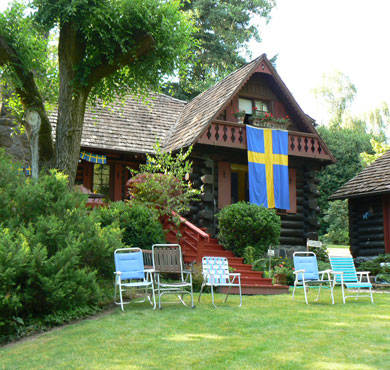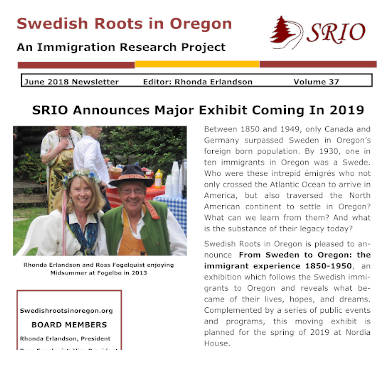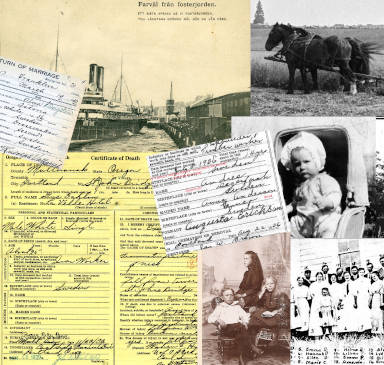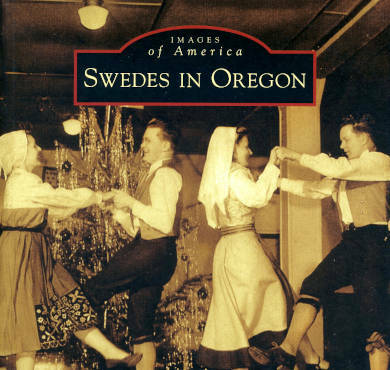About Swedish Oregon
Note: This book is sold out
Swedes began filtering into the Oregon Territory with the first wave of white settlers. At first their numbers grew slowly, but after 1883, when the railroad connected Portland to the national grid, the flow accelerated. By1910, the Swedes were the second-largest foreign-language immigrant group in the state. The influx diminished by the end of the 1920s, and ever since Swedish immigration to Oregon has been a tiny but steady trickle.
Compiling wide-ranging material—some of it never before translated into English—and none of it ever collected and introduced, Swedish-American author Lars Nordström invites the reader on a fascinating journey through the Swedish history of the state of Oregon from the late 1800s into the 21st century.
“Lars Nordström is presently the leading expert on the Swedes in the Northwest: both those who settled there during the era of the Great Migration and those who have come after, down to the present, from a very different Sweden to a very different America. His study is based on extensive research while as an immigrant from Sweden himself, he has a particularly sensitive understanding of the personal dimensions of the migration experience, which he eloquently conveys in lucid prose.”
H. Arnold Barton, Professor Emeritus, Southern Illinois University Carbondale
“This volume, another in the excellent series to come from Swedish Roots in Oregon, makes an important contribution to our understanding of Swedish America. It is especially significant because it moves the focus out of the Midwest and expands our knowledge of an often-ignored region. Furthermore, the variety of chapters helps one to see more deeply into the complex lives of Swedish Americans across several generations.”
Byron J. Nordstrom, Editor of The Swedish-American Historical Quarterly.
“In SWEDISH OREGON, editor Lars Nordstrom invites readers to a veritable smorgasbord: fresh translations, new bi-lingual poems, green diaries, savory articles, light sketches, a tangy interview, seasoned memoirs, distilled photographs. As in his award-winning memoir Making It Home (1997), Nordstrom—a distinguished scholar, translator, and poet—again gives hungry readers an anthology that relishes 150 years of rich and invisible emigrant experience.”
George Venn, General Editor Oregon Literature Series
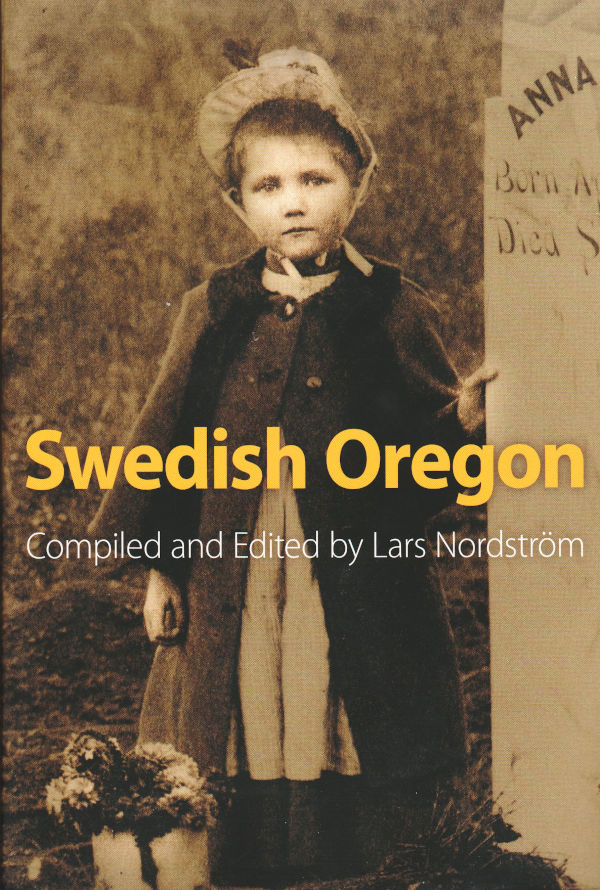
Swedish Oregon Excerpt
This is a book that explores over a century of Swedish history in Oregon. It is a book about change, continuous and inevitable change. The reader will embark on a journey through a little-known aspect of Oregon’s history—namely the Swedish experience in the state. Beyond that, my hope is that this wide-ranging material will give every reader a greater understanding of what it means to be an immigrant, regardless of nationality or religious faith. Also, what it means to claim and celebrate an ethnic heritage, and what some of the historical forces are that have shaped these experiences.
This is also a book about personal experience by ordinary people. Much of the material gathered here comes from individuals who wrote down what they remembered of what they saw and felt. The men recorded the facts that interested them. The women provided a different perspective on the same reality. What they had in common was that they were witnesses, present at a certain time and place. They wrote their impressions down without giving much thought to an audience, which gives their texts a wonderful immediacy. They happen to be Swedish, but they could just as well have been one of many other nationalities. Their personal experiences are specific, yet ultimately just facets of the richness of universal human experience.
Immigrants have written all the chapters in this book—with two exceptions—Martin Peterson and William Carlson Smith, who were both sons of Swedish immigrants. Clearly, firsthand familiarity with the immigrant experience provides a deeper understanding of the many facets of bi-cultural identity. They know what it is like to have two places to call home, two languages, and two views of the world. This circumstance alone gives the material an undeniable authenticity.
The material collected here certainly reflects the way Oregon has evolved, but it primarily focuses on the shifting nature of the Swedish immigrant experience. Many of these chapters clearly show the transformative processes that have been part of this history. Some of these forces have been external, such as the active “Americanization” movement around World War I, whereas others have come from changes within the Swedish community itself, such as losing the language.
Many Swedish immigrants were open to a new life and willingly let go of the past while embracing their new homeland. Others were more reluctant and resisted change. Some could not adapt at all and ultimately ended up moving back. Those who stayed faced a daily reality in which it was increasingly difficult to conserve an ethnic identity in a greater culture made up of so many different groups, each with its own unique traits. It was difficult to maintain one’s native language. It was hard to keep in touch with family, friends and culture “back home.” It was a challenge to preserve traditions, customs, and cuisine. Eventually, as the US Census record informs us, the Swedish history of Oregon becomes a story of assimilation.
To better understand the historical context that gave rise to the Swedish community in Oregon in the first place, it is helpful to take a quick glance at the country these early emigrants left. They emigrated from a primarily agricultural society that had run out of arable land almost a century earlier, and where almost half the population consisted of landless farm workers. It was a rigidly structured class society (dominated by the aristocracy, clergy, burghers, and large-scale farmers) that strictly enforced the status quo.
In the eyes of the emigrants, their homeland appeared unable to offer the steadily growing population any probability of a better life. It was also a society that looked down upon emigrants as deserters or even traitors to their country. It is no great surprise that the democratic and egalitarian ideals of the dynamically expanding, technically innovative United States had a tremendous appeal to them. In their new homeland virtues such as hard work, frugality, and perseverance—not only inherited wealth and station—offered possibilities and life styles that could never have been imagined in their old homeland. Understandably, this colored their views both of America and Sweden.
As increasingly large numbers of Swedes started immigrating to the United States during the second half of the 19th century—eventually almost twenty percent of the entire population emigrated—Sweden started changing as well. The old agrarian society urbanized and industrialized, and the old power structure was replaced by a new one. The aristocracy lost its influence and the once dominant role of church and faith began declining. Re-migration of Swedes with some capital and a myriad of new ideas brought substantial change to Sweden as well. European Socialist ideas and the efforts to unionize also became widespread, and this colored Sweden’s political and social evolution. With the great exodus to America, general living conditions steadily improved for those who stayed.
Slowly, but surely, this change started to erode the reasons to emigrate. And as Sweden changed, the Swedes did too. The emigrants who left Sweden in the 1920s, many of whom ended up in the Pacific Northwest, marked the definitive end to substantial Swedish emigration to America. Many of them had close relatives that had come earlier, and family reunification was still a reason for leaving. These Swedes had a very different view of their native country from those who had left a generation or two earlier. They were not primarily farmers, but urban people. They also came to a different United States where the frontier had long since closed, and where the population had just tipped from being mostly rural to becoming predominantly urban.
Perhaps every ethnic community within a larger society requires a certain “critical mass” to be able to maintain its uniqueness, a constant invigoration through continuous immigration. In Oregon, the Swedish community’s loss of critical mass coincided with the Great Depression, even though 1930—paradoxically—was the year with the highest percentage of Swedes in Oregon’s immigrant population. Throughout the decade that followed, more Swedes returned to Sweden than actually immigrated to the United States. As a result, the underpinnings of the Swedish community—the Swedish-language newspaper, the Swedish stores, restaurants, organizations, and so on—started crumbling and the Swedes began morphing into a less conspicuous Swedish-American presence, becoming one of many hyphenated ethnic groups.
Following World War II, immigration to the United States from Sweden never gained momentum again. In terms of numbers, post-war immigration of native Swedes to the United States has been nothing but a tiny trickle of individuals. Again, these immigrants have come from yet another kind of Sweden, shaped by a different history and political and cultural debate—different both from earlier days in Sweden and from that of the United States. These recent Swedish immigrants have often been well educated, and, unlike their predecessors, fairly fluent in English on their arrival. Leaving an affluent and egalitarian society that stressed peacefulness, conflict resolution, and social responsibility, they do not share that feeling of rejection that so many of the earlier Swedish immigrants felt. They are much less likely to hold a grudge against post-war Sweden, and tend to be more liberal, politically and socially, than most Americans. Many have emigrated for love or job offers, and practically no one has immigrated to join close family members already here. Swedes are now (since 2001) allowed dual citizenship, and many recent immigrants eventually end up moving back.
One result of this tiny stream of immigrants for over half a century has been that the community of foreign-born Swedes in the United States—and Oregon—has kept shrinking. Overall, since 1970, it has decreased by over 60 percent. There are no indications that this trend will change. On the contrary, with Swedish membership in the visa-free European Union in 1995, an increasing number of those Swedes who seek a new life abroad do so within Europe, not by moving to the United States.
What a newly arrived Swedish immigrant in Oregon finds is that there is no longer a Swedish enclave in the state, but instead a growing Swedish-American community. According to the latest US Census, more than 125,000 Oregonians now regard themselves as Swedish-Americans. Some of them work diligently to keep various organizations going, and they keep a large number of Swedish traditions and customs alive. Some recently arrived Swedes, of course, also participate in the Swedish-American efforts to celebrate aspects of a Swedish heritage—and they gather together at lodge meetings, Christmas time, Midsummer, or around an August table full of crayfish.
?
In an attempt to orient the reader in time and space, each chapter of this book has been provided with an introductory preface providing a brief historical context. A few words about the source of the material and the author or translator have also been added. Occasionally a postscript has been included, giving the reader a glimpse of what happened after that particular story ended. The curious reader, who would like to dive even deeper, will find endnotes at the end of almost every chapter. Most of them will simply refer to the source of a specific claim or statement, or contain an explanation of a word or term. At the end of the book the reader will also find an index of key words. Finally, there is a bibliography of books in Swedish and English, all with some connection to Swedish Oregon for anyone who would like to explore the subject further.
A selection of historical photographs, drawings, prints, and ads has been inserted to add a visual dimension to the various chapters. Give these illustrations a bit of time. Try to imagine the daily life that surrounded the individuals, the time, and the place. Our grandparents probably met some of the people mentioned in this book—on the street, in church, or at work. Perhaps they exchanged a few words about the weather, the outlook for the coming harvest, the local economy, the ailing grandfather, or the daughter getting married at Midsummer. In so many ways, their voices are just like ours. We honor them by not forgetting.
